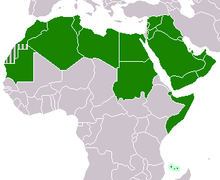Somaliwood
Somaliwood is an informal name for the Somali film industry that has developed in Columbus, Ohio, where a large Somali diaspora exists.[1][2][3] Following the model of Bollywood, the name is a portmanteau of the words "Somali" and "Hollywood", the center of the American film industry.
| Cinema of Somalia |
|---|
  |
| List of Somali films |
| Somali Film Agency |
| Somaliwood |
Overview
—Abdisalam Aato on Somaliwood and his film company Olol Films[4]

The earliest forms of public film display in Somalia were Italian newsreels of key events during the colonial period in Italian Somaliland. Growing out of the Somali people's rich storytelling tradition, the first few feature-length Somali films and cinematic festivals emerged in the early 1960s, immediately after independence.[5] Following the creation of the Somali Film Agency (SFA) regulatory body in 1975, the local film scene began to expand rapidly.[6] In the 1970s and early 1980s, popular musicals known as Riwaayado were the main driving force behind the Somali movie industry. Epic and period films as well as international co-productions followed suit, facilitated by the proliferation of video technology and national television networks.[5]
In the 1990s and 2000s, a new wave of more entertainment-oriented movies emerged in the Somali diaspora. Referred to as Somaliwood, this upstart cinematic movement energized the local movie scene, in the process introducing innovative storylines, production techniques and advertising strategies. The latter include cross-media marketing, with tie-in film soundtracks featuring prominent Somali music artists. Popular movies from Somaliwood include the Somali language slasher thriller Xaaskayga Araweelo, the action comedy Rajo, and Warmooge, the first Somali animated film. The young directors Abdisalam Aato of Olol Films and Abdi Malik Isak are at the forefront of this quiet revolution.[4] In 2010, the Somali director Mo Ali also released Shank, his first feature film set in a futuristic London.[7]
See also
- List of Somalian films
- Somali Film Agency
- Hollywood-inspired names
Notes
- "Director provides information about people of Somalia". The Columbus Dispatch. 2007-10-12. Retrieved 2008-01-25.
- "Somalis Try to Eradicate "Bad Habit" from Africa". The Columbus Dispatch. 2006-11-27. Retrieved 2008-01-25.
- "Olol promo material" (PDF). Olol Films. Retrieved 2008-01-25.
- "Somaliwood: Columbus Has Become A Haven for Somali Filmmaking". The Other Paper. 2007-04-19. Retrieved 2008-01-25.
- History of Cinema in Somalia
- Abu Bakr, p.25
- "Live East's Tips for the Top: Who's Hot" (PDF). Live East Magazine (Spring 2010): 18. Retrieved 5 August 2010.
References
- Abu Bakr, Yahya; Saad Labib; Hamdy Kandil (1985). Development of communication in the Arab states: needs and priorities. Unesco. ISBN 92-3-102082-X.
- Armes, Roy (2008). Dictionary of African filmmakers. Indiana University Press. ISBN 92-3-102082-X.
- Association des trois mondes (2000). Cinémas d'Afrique. KARTHALA Editions. ISBN 2-84586-060-9.
- Farīd, Samīr (1979). Arab cinema guide. s.n.
- Kaplan, Irving (1977). Area handbook for Somalia. U.S. Govt. Print. Off.
- Legum, Colin; John Gordon Stewart Drysdale (1976). Africa contemporary record, Volume 8. Africana Pub. Co. ISBN 0-86036-030-X.
- Ministry of Information and National Guidance (1974). Somalia: five years of revolutionary progress. Ministry of Information and National Guidance.
- National Endowment for the Humanities. Media log: a guide to film, television, and radio programs supported by the National Endowment for the Humanities. The Endowment.
- R R Bowker Publishing (1995). Bowker's complete video directory (Volume 2). R.R. Bowker. ISBN 0-8352-3588-2.
- Xodo, Chiara (August 2008). "Catalogo Audiovisivi (con schede didattiche)" (PDF). Centro Interculturale Millevoci, Provincia Autonoma di Trento Dipartimento Istruzione. Archived from the original (PDF) on 2009-12-22. Retrieved 2009-09-25.
